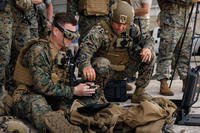The Marine Corps recently called on defense firms to submit proposals for a new lightweight body armor plate that's about 38 percent lighter than the current plates used to protect Marines from rifle fire on the battlefield.
Marine Corps Systems Command is seeking proposals from industry for procurement of a "maximum of 680,706, and a minimum of 60,000, lightweight plates," according to a Nov. 29 release announcing the request for proposal.
The new plates will be fielded in addition to the enhanced small arms protective insert (ESAPI) plates now in use to give commanders a lighter option for low-intensity threat environments.
"We expect the plates to be at least 38 percent lighter than the ESAPI, which will significantly increase the mobility of Marines on the battlefield," said Nick Pierce, team lead for individual armor team at Systems Command's Program Manager Infantry Combat Equipment.
A medium-sized ESAPI plate weighs about 5.5 pounds.
In August, Systems Command assessed the defense industry's capabilities for making plates to supplement the ESAPI plate and provide sufficient protection for most combat environments, the release states. It held industry days in October and met with 12 companies to receive feedback on the draft solicitation documents.
All proposals are due in March 2019, and a contract is expected to be awarded in July 2019, according to the release. Initial fielding could happen as early as fiscal 2020, officials said.
"This, along with other recent initiatives such as the Plate Carrier Gen III, are part of a holistic effort to modernize the personal protective equipment set to give Marines better, lighter, more effective gear," Pierce said.
The Corps awarded a $62 million contract in late September to New Jersey-based Vertical Protective Apparel LLC to produce and deliver up to 225,886 Plate Carrier Generation IIIs.
The new plate carrier design features less material to make them lighter than the current carriers. They also are made from a laminated laser-cut material, which reduces water absorption.
The new carriers come in eight sizes and offer better ballistic protection compared with current designs, according to the release.
-- Matthew Cox can be reached at matthew.cox@military.com.










